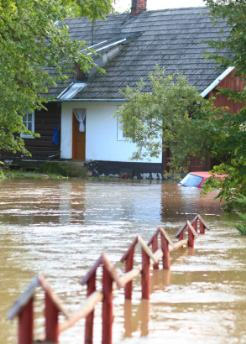Are your flood insurance costs going to rise?
Emmet Pierce
Following a series of storms that have battered coastal regions of the U.S. in recent years, the federally administered National Flood Insurance Program NFIP) is reevaluating who truly needs flood insurance and how much it should cost for businesses and homeowners.
The NFIP, which was founded in 1968, has been subsidizing flood-prone communities by holding down insurance costs. The Federal Emergency Management Agency FEMA) says the program has required $24 billion in federal bailouts since it was formed, because flood insurance premiums often are set too low.
 In order to stay in business, private insurance companies must set their premiums high enough so they have a pool of money big enough to pay all claims.
In order to stay in business, private insurance companies must set their premiums high enough so they have a pool of money big enough to pay all claims.
Until now, the NFIP has relied on loans from the federal government rather than increasing its premiums to reflect true flood risks. As a result, the NFIP is losing money.
However, the National Flood Insurance Program is addressing this problem. Beginning in 2013, the program is moving to a risk-based system. That means the higher your area’s risk of flooding, the more you will pay.
“The new) premiums will be based on the latest flood insurance rate maps, and those maps will be constantly updated,” says Edith Lohmann, a national flood insurance specialist for FEMA.
FEMA plans to phase out subsidized rates for policyholders with homes built before local community flood maps were created back in the l970s and 1980s. The agency estimates that 20 percent of the NFIP’s 5.5 million policyholders receive these subsidies.
What does flood insurance cover?
Standard business and home insurance policies don’t cover flood damage. Supplemental flood insurance is required for homeowners with federally backed mortgages who live in high-risk areas. The pool of those policyholders is expected to grow when federal flood maps are updated.
Mark Goldman, a real estate instructor at San Diego State University, says the increasing number of floods the U.S. has experienced in recent years is linked to global warming and climate change.
“If the flood maps are changing it is because there’s an expectation that flood zones are changing,” Goldman says.
Goldman notes that mortgage lenders with government-backed loans must require flood insurance of their borrowers when the risk of flooding is great.
Floods are the most common form of natural disaster in the U.S. A flood can be caused by a variety of things, such as hurricanes, damaged levees, clogged drainage systems or heavy rainfall. If you live in a high-risk zone, FEMA says you have a 26 percent chance of experiencing a flood over the course of a 30-year mortgage loan. The average flood insurance claim is about $35,000.
Coastal communities, such as those along the Gulf of Mexico and the Eastern Seaboard, and communities near inland waterways like the Mississippi River are likely to be hardest hit by flood insurance price increases.
The effort to make the NFIP solvent
To restore the NFIP’s financial stability, Congress approved the Biggert-Waters Flood Insurance Reform Act of 2012. The act seeks to make sure that flood insurance rates accurately reflect the actual risks of flood damage.
Annual NFIP premiums for homeowners currently average $625. However, the cost can exceed $3,000 for maximum coverage in coastal areas where the risk of flooding is high.
About 250,000 businesses and nonprimary residences — such as vacation and rental homes — will see increases under the Biggert-Waters Act. The policy increases can be no more than 25 percent in 2013.
“Only about 20 percent of the entire NFIP policy base will see any increase in 2013,” Lohmann says. “Those will be the policies that are subsidized in high-risk areas.”
FEMA will begin phasing out subsidies for primary residences in 2014. No cap has yet been set for increases on primary residences. Many residential policyholders who live in hazardous areas will be allowed to retain flood insurance subsidies until they sell their homes or suffer severe flood losses, Lohmann says.
An uncertain future for flood insurance rates
Lohmann says not all flood insurance reform news will be bad for home and business owners. An undetermined number of property owners will experience rate reductions, as maps are adjusted.
Consumers can determine their risk of flood, based on the latest federal flood maps, by going online to FloodSmart.gov. The flood risks people now can find online reflect the most current information available and will be updated over time, Lohmann says.
“The maximum amount of coverage property owners can buy through their local agent is $250,000 on a residential building and up to $100,000 on personal contents,” she says.
High-value homes may need more coverage than the NFIP provides. Additional flood insurance can be purchased from private insurers for such property owners and for people who live in communities that don’t take part in the flood insurance program. FEMA says that as of July 18, 2013 there were 21,952 participating NFIP communities and 2,054 that were not taking part.
Because the NFIP is voluntary, each community must weigh its risk for flood damage before deciding whether to participate.
Typically, small communities located outside flood hazard areas choose not to participate. Some may choose not to participate because they don’t want to spend money from their municipal budgets on monitoring building permits or counseling contractors about flood risks, as is required by the program, Lohmann says.
See how much you could save today on your home insurance. Get your free home insurance quotes today!
